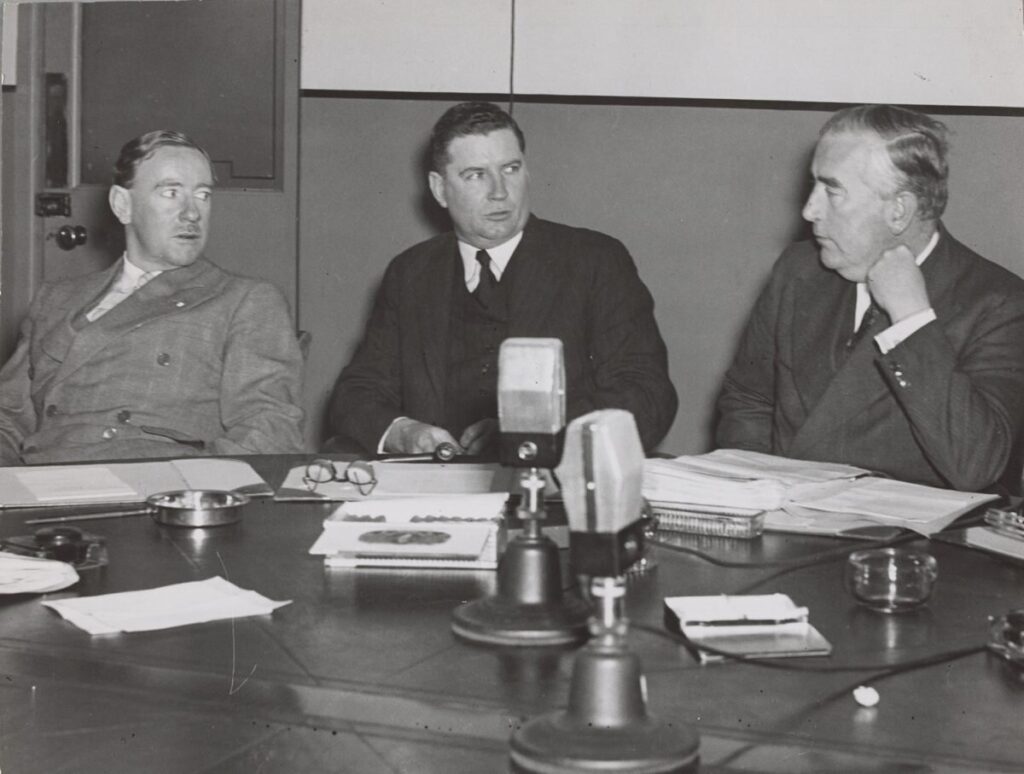On this day, 1 September 1951, the Menzies Government signed the ANZUS Treaty, forming a defensive pact with the United States of America and New Zealand. The treaty stated that ‘each party recognises that an armed attack in the Pacific area on any of the Parties would be dangerous to its own peace and safety and declares that it would act to meet the common danger in accordance with its constitutional processes’. Formed in the specific circumstances of the Cold War, ANZUS has endured vast shifts in geopolitical circumstances to remain a vital and living document. Though New Zealand has had a rocky relationship with the treaty, for Australia it has stood the test of time and remains the cornerstone of our strategic defence after 70 years. In his farewell press conference in 1966 Menzies reflected that ‘If I were asked which was the best single step that had been taken in the time of my Government I think I would say the ANZUS Treaty’.
In his first volume of memoirs titled Afternoon Light, Menzies argued that ANZUS was underpinned by the shared history and values of Australia and America, including the rule of law, popular self-government, religious faith, a passion for individual and national freedom, and the fact that the Australian Constitution was partly based on the American Constitution. Menzies had taken some time to develop these views, as during his first trip to the United States he had reacted negatively to what he saw as key cultural differences between Britain and her republican offshoot. Menzies was sentimentally an Empire man, but he could adapt to the necessities of changing circumstances and was always willing to put Australia’s interests first. It was for that reason that he appointed Australia’s first legation to the United States in 1940.
The Second World War would prove the appointment prescient, as Australia would ultimately have to rely on America rather than her traditional protector Britain to take the lead role in defeating Japan. In the aftermath of this occurrence, both sides of politics were anxious to secure a lasting security pact with America to compel her to come to Australia’s aid should she ever need it again. The Menzies Government was ultimately able to procure this thanks to shrewd diplomacy combined with a unique mix of circumstances. One was Australia’s prompt committal of ground troops to the Korean War. Menzies had actually been quite hesitant to make such a commitment, and the decision was ultimately made by Arthur Fadden as Acting Prime Minister while Menzies was at sea. Nevertheless, the United States, which led what was a UN backed force in Korea, was grateful for the support.
Just as important was America’s wish to secure a ‘soft’ peace treaty for Japan which would allow the defeated foe to rearm in some compacity and become an important strategic ally in the Cold War. The articles of Japanese surrender had been signed by eleven countries, and America needed a majority to sign on to her plan. Considering the Soviet Union was one of those countries, Australian, New Zealander, and British acquiescence would be vital. Even if America somehow secured the votes without them, the Commonwealth powers could potentially boycott Japan economically in a manner that would undermine America’s strategy. With fresh memories of the horrors of the War, Australia was obviously hesitant to risk a Japanese resurgence, but ANZUS gave them the reassurance that America would defend them should Japan once again go rogue.
A third circumstance was Australia’s planned role as part of the democratic forces should the Cold War erupt into a global conflict. As Australia had done in both World Wars, she was expected to send troops to the Middle Eastern theatre. However, the experience of the fall of Singapore made Australia naturally hesitant to leave herself vulnerable like this. ANZUS would ‘close the backdoor’, allowing Australia commit her forces with the reassurance that America would defend her in the meantime.
There is much debate over who is responsible for ANZUS. Menzies’s Minister for External Affairs and later Ambassador to the United States Percy Spender would claim that it was ultimately his doing, and that Menzies initially distrusted what he thought would prove to be ‘a superstructure on a foundation of jelly’. However, Menzies can take credit on two crucial points. The first is resisting British opposition to a treaty that excluded them. Indeed, despite the stereotype of Menzies as a helpless anglophile ANZUS and the later commitment to Vietnam were actually defining moments in Australia exercising a foreign policy separate from Britain. The second is taking a long-sighted view towards Japan that was highly controversial at the time. Opposition Leader H.V. Evatt supported ANZUS but was far more hesitant about the peace treaty that facilitated it. Menzies’s famous commerce treaty with Japan in 1957 may be seen as part of the ANZUS episode, following the American vision it helped Japan to remerge as an economic power that would therefore be a strong ally.
Further Reading:
Percy Spender, Politics and a Man (Collins, 1972).
Robert Menzies, Afternoon Light: Some Memories of Men and Events (London Cassell, 1967).
Sandra Penrose, ‘Percy Spender and the Origins of ANZUS: An Australian Initiative’, Refereed Paper presented to the Australian Political Studies Association Conference 2004.
Sign up to our newsletter
Sign up for our monthly newsletter to hear the latest news and receive information about upcoming events.


